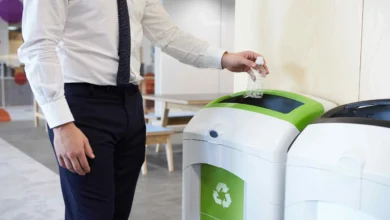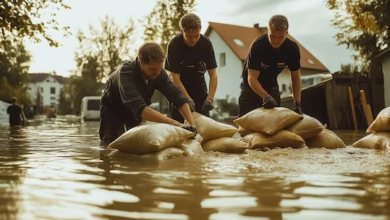Junk Removal for Disaster Recovery: Floods, Fires, and Storms

Natural disasters such as floods, fires, and storms often leave behind a trail of destruction, creating a massive cleanup challenge. From water-damaged furniture to fire-charged debris, dealing with the aftermath can feel like an insurmountable task. That’s where professional junk removal services come in, offering expertise, tools, and manpower to help you recover faster and more efficiently.
The Role of Junk Removal in Disaster Recovery
Here’s how junk removal services make a difference:
- Efficient Cleanup
Junk removal companies are equipped to handle large volumes of waste and debris, ensuring faster cleanup. They have tools like trucks, dumpsters, and specialized equipment to tackle even the most extensive damages. - Safety First
Disasters often leave behind hazardous materials such as mold-infested furniture, sharp debris, or toxic ash. Professionals are trained to handle and dispose of these items safely, minimizing health risks. - Sorting and Recycling
Service providers of junk removal in Doylestown PA prioritize recycling, separating salvageable materials from waste. For example, metals, electronics, and glass can often be recycled, reducing the environmental impact of disaster cleanup. - Compliance with Local Regulations
Disaster waste disposal often involves strict regulations. Junk removal experts are well-versed in local codes, ensuring that debris is disposed of legally and responsibly.
Specific Scenarios: How Junk Removal Helps
1. Flood Cleanup
Floodwaters can damage furniture, appliances, and building materials. Mold growth begins within 24-48 hours, making prompt action critical. Junk removal services:
- Remove waterlogged furniture and carpets.
- Dispose of damaged drywall and insulation.
- Safely discard items contaminated by sewage or chemicals.
2. Fire Recovery
Fires leave behind ashes, soot, and damaged items that are often unsalvageable. The cleanup process involves:
- Clearing out burnt furniture and debris.
- Disposing of hazardous materials like fire retardants or chemicals.
- Removing smoke-damaged items that pose health risks.
3. Storm Debris Removal
Storms can scatter branches, trees, roofing materials, and broken glass across your property. Junk removal services provide:
- Safe removal of fallen trees and large debris.
- Cleanup of construction materials and damaged structures.
- Responsible disposal of sharp or hazardous objects.
Steps to Streamline Junk Removal After a Disaster
- Assess the Damage
Take stock of the affected areas and identify items that need immediate removal. Create a list of priorities to share with the junk removal team. - Document for Insurance
Before removing anything, photograph the damage for insurance claims. Many policies cover debris removal as part of disaster recovery. - Separate Salvageable Items
Work with professionals to identify items that can be repaired or reused. This helps reduce waste and save costs. - Hire a Licensed Junk Removal Company
Ensure the company you choose is licensed, insured, and experienced in disaster recovery. Check reviews and ask about their handling of hazardous materials. - Coordinate with Local Authorities
Depending on the scale of the disaster, local authorities may provide guidelines or support for debris disposal. Stay informed to avoid legal issues.
The Benefits of Hiring Professionals
- Time-Saving: Disaster recovery is time-sensitive. Professionals work quickly to restore normalcy.
- Comprehensive Solutions: From large debris to hazardous waste, they handle it all.
- Reduced Stress: Outsourcing cleanup allows you to focus on other aspects of recovery.
- Eco-Friendly Disposal: Junk removal companies ensure environmentally responsible practices.
Tips for Choosing the Right Junk Removal Service
- Look for Experience
Choose a company with a proven track record in disaster recovery. - Verify Insurance and Licensing
Ensure they are licensed to handle hazardous materials and insured against accidents. - Check for Recycling Practices
Select a service that prioritizes recycling to minimize waste. - Get a Clear Estimate
Request a detailed quote to understand costs upfront and avoid surprises.
Conclusion
Recovering from disasters like floods, fires, and storms can be overwhelming, but professional junk removal services simplify the process. With their expertise, tools, and commitment to safety, they ensure efficient cleanup, helping you focus on rebuilding your life. Remember, choosing the right service is key to a smooth recovery—look for licensed, experienced, and eco-conscious professionals to get the job done right.
See Also : Estate Planning 101: Everything You Need to Know to Protect Your Assets
FAQs
1. What types of items can junk removal services handle after a disaster?
Junk removal services can handle a wide range of items, including damaged furniture, appliances, construction debris, and hazardous materials like moldy items or fire-damaged materials.
2. How much does disaster recovery junk removal cost?
Costs vary based on the extent of the damage, volume of debris, and location.
3. Can junk removal services help with insurance claims?
Yes, many companies provide documentation and itemized receipts to support insurance claims. Some may even liaise directly with insurance adjusters.
4. How quickly should I hire a junk removal service after a disaster?
It’s best to act within 24-48 hours, especially for flood cleanup, to prevent mold growth and further damage.




